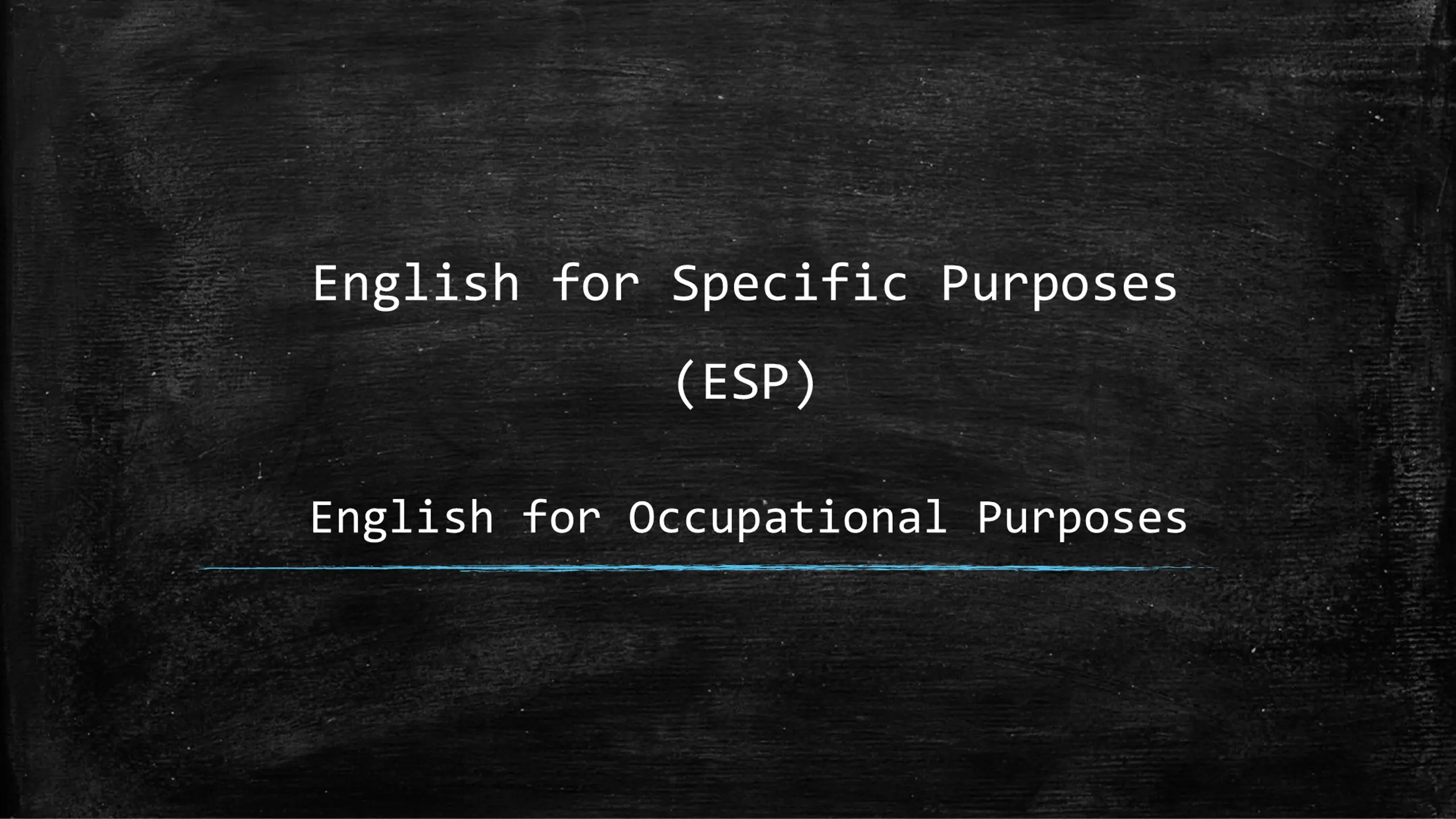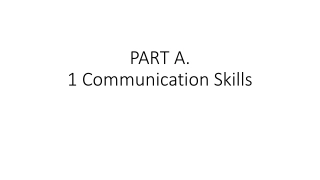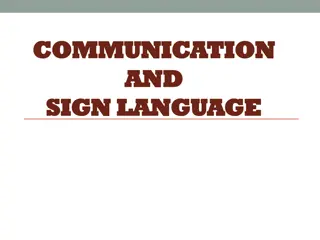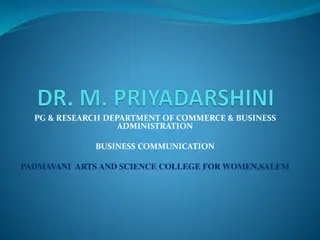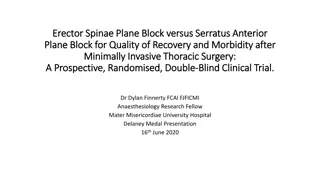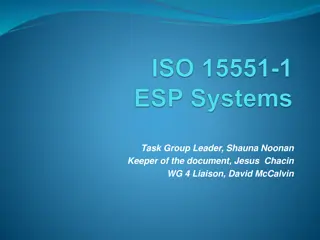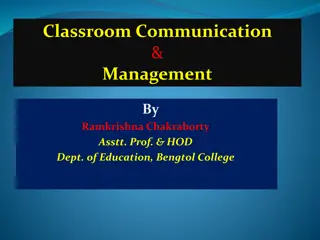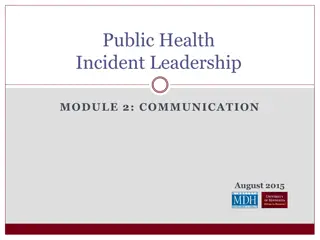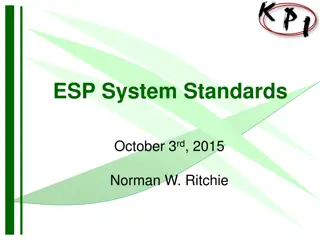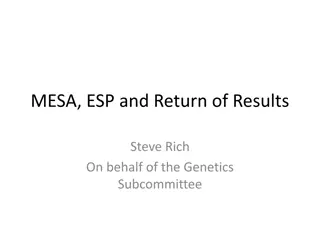Enhancing Professional Communication Through ESP
Explore the importance of English for Specific Purposes (ESP) and its branches, like English for Occupational Purposes. Discover how proficiency in ESP, fluency, and command of language can be vital for effective communication in fields like Medicine and Science.
Download Presentation

Please find below an Image/Link to download the presentation.
The content on the website is provided AS IS for your information and personal use only. It may not be sold, licensed, or shared on other websites without obtaining consent from the author.If you encounter any issues during the download, it is possible that the publisher has removed the file from their server.
You are allowed to download the files provided on this website for personal or commercial use, subject to the condition that they are used lawfully. All files are the property of their respective owners.
The content on the website is provided AS IS for your information and personal use only. It may not be sold, licensed, or shared on other websites without obtaining consent from the author.
E N D
Presentation Transcript
English for Specific Purposes (ESP) English for Occupational Purposes
ESP English for Specific Purposes (ESP) is a learner-centered approach to teaching English as an additional language, which focuses on developing communicative competence ina specific discipline. ESP is ESL (English as a Second Language) instruction for a particular speech community, occupational field, or workplace situation. The basis of ESP is the teaching of language using content or subject matter. English covers situations in which learners are studying English for work- related reasons, therefore based on an analysis of their specific communicative needs in their work. for Occupational Purposes is a branch of ESP and
Key terms for language ability Proficiency Abilityto thinkinthe language,voiceopinionsandideas,extrapolate, put voiceto humor,nohesitationincommunication,possessionof decisionmakingskills,ability touse synonymswithcompetency. Fluency Abilityto communicate orallyinthelanguagewith little hesitationor need for translation before speaking, yet less able to engage in complex discussionsorutilizeadvancedortechnicalvocabulary. Mayfacechallengeswithlistening,readingand/orwriting. Command Possession of and ability with a broad, general vocabulary that allows a person to function in the new language to connect with others on an everyday basis. Mayequate to a degree of fluency if repertoire and ease are sufficient.
Medical language A Language for Specific Purposes Medical language is a distinct variation of language: an advanced form of standard language (Hull, 2014). Itis aLanguageforSpecificPurposes.Medicallanguageexists inlanguagesworldwide. Hull (2014, 2013b, 2010) believes it is a universal construct applicable to all health and allied health professions. It is their shared language and non-members of this group can struggle to comprehend it. Medical language is not simply medical terminology and the synonymous use of these two terms is inaccurate. While medical terminology is foundational to medical language, it is simply a corpus a body of words. A very large vocabulary that still requires an understanding of context, grammar and syntaxinorder to be usedcorrectly. Medical terminology has to be put to use effectively and appropriately in a healthcare context. It is neither reasonable nor safe to assume that a health professional can function in such an environment withonlyalargerepertoire ofmedical terms (Hull,2014,2013b). Proficiencywith medical languageis necessaryfor successfulcommunication. Effective communicationcanbe, infact,linkedtoclinicaloutcomes.
Scientific English Pharmacists need to be able to communicate, both verbally and in a written format, with people in the community, colleagues and other health professionals using educated, elaborated English. English language skills and communication skills are not one and the same, the latter implying the effective use of written or spoken language to impart information or ideas. Good English language skills however, underpin good communication in English. The need for English as a professional language in medicine (and allied health professions) is nowadaysbeyond doubt. Scientific literature and the internet are just two examples that reveal the overriding necessity for understanding and expressing ourselves in written andspoken English. (Ribes & Ros, Medical English)
Scientific English At present scientists are compelled to publish their papers and studies in English becausescience hasadopted English as its linguafranca. Knowing how to succeed in any scientific environment framed by the English language is, therefore, vital. What makesascientific paper, scientific? Scientific papers have fourmajorcharacteristics: They use technical language (i.e. words which embody facts and principles belonging toa particular scientific field orresearcharea); They start with anabstract (a brief, reasonedsummary); They are written in accordance with the IBC strategy, i.e. the requirement on the authors part to address the topic keeping in mind three different modules:Introuction,BodyandConclusion. They arepublished in specialized journalsandreviews.
Scientific English Scientific papers can be classified in two broad categories: research and descriptive papers. They all follow the IBC strategy: true premises are set in the introduction, a valid argument is made in the body and true conclusions arethen derived in the final sections. Even simple paragraphs can be composed according to this structure: a topic can be introduced with an opening sentence and a conclusion can be drawn by way of a closing sentence, but not before developing the topic further arguingfororagainstit in the body ofthe paragraph. This is the way successful academic writers phrase their thought process:in alogically sound way.
Scientific English A research paper is a written document that presents the results of original research, analysis, and interpretation of data and information related to aspecific topic orquestion. Research papers are typically written by researchers or scholars in various fields, including science, social science, humanities, and engineering. They follow a standard format and structure, which includes an introduction, literature review, methodology, results, discussion, andconclusion.
Scientific English In a research paper, the author(s) present their research findings, analysis, and interpretation, supported by evidence and citations from previous research. The paper may also include tables, figures, graphs, orother visual aids to help present the data andresults. Research papers are often published in academic journals or presented at conferences, and are subject to peer review by other experts in the field. The purpose of a research paper is to contribute new knowledge or insights to the field, and to support the ongoing conversation and advancement ofknowledge within that field.
Scientific English A descriptive paper is a type of academic writing that describes a person, place, object, or event. Unlike a research paper, which presents original research and analysis, a descriptive paper focuses on providing adetailed andvivid description ofaparticularsubject. In a descriptive paper, the author uses sensory details such as sight, sound, smell, taste, and touch to create a vivid picture of the subject in the reader's mind. The author may also use literary techniques such as metaphor or personification to enhance the description and create a moreengaging readingexperience.
Scientific English Descriptive papers can be written in a variety of styles and formats, depending onthe intended audienceandpurpose. For example, a descriptive paper about a historical monument may be written in a more formal and objective style, while a descriptive paper about a personal experience may be written in a more subjective and emotionalstyle. Overall, the goal of a descriptive paper is to provide the reader with a clear and engaging picture of the subject being described, without necessarily presenting original researchoranalysis.
Scientific English No matter their typology, all research papers generally deal with large quantities of data, procedures, and theoretical constructs, giving rise to the issue ofhow to convey in an easily accessible and standardized way that bulkofinformation. The IMRaD format is a solution to this problem, and the most widely usedlayoutfororganizing empirical content into papersections. The term IMRaD is an acronym standing for the words Introduction, Mehtod, Results andDiscussion. It refers to the way in which information should be presented in a paper.
Scientific English Abstracts All scientific papers start with a reasoned summary. That reasoned summary is known as abstract. Abstracts are documents in themselves; as a rule, readers should never need to review an entire paper in order to understand its abstract. Abstracts are concise paper overviews providing explicit information on a paper s topic, and contain keywords of the larger work: the more self-contained they are, the better. Sometimes abstracts also anticipate the theses, experiments, lines of argument and conclusions contained in the body of the paper, however in anabridged andhighly condensed way.
Scientific understanding The majorcomponentsofscientific construction The backboneofbothscientific understanding andacademic publications. sentence connectors. Grammatical categories such as conjuntions, adverbs and phrases serve a precise function:they link oneormorelinguistic units together: Conjuntions: for, and, or, nor, but, so, yet, because, although, despite, even though, while, whereas, whenever [ ] Adverbs: always, sometimes, before, after, usually, never, arguably, likewise, similarily, hence,therefore,nevertheless [ ] Phrases: according to the theory, on the contrary, to sum up, in other words, unlike manyotherresesarchers... [ ]
Scientific understanding Sentence connectors, therefore, serve a precise communication function: they mirror logical relations holding among and between ideas.This is their functionin discourse. Sentence connectors are conjuctions, adverbs and phrases used to logically joinsomeexpressions inatext. They help writers to convey their thoughts and reasoning on a particularr topic theyarediscoursemarkers. Reading scientific texts is not comparable to reading poetry in science, what really matters is logical relations among words, thoughts andfacts.
Scientific understanding Apaperis divided into paragraphs,andthus it is a chainofparagraphs. A paragraph can accomplish several different actions, such as describing an experimental method, arguing a relationships. It generally focuses on something, or has a topic. Paragraphs must develop their topic in a logical, coherent way. Often a paragraph will clearly state its purpose within the first sentence, bringing into focus its key conceptsandhowthey will bediscussed. theory, explaining cause-effect Experienced academic readers are capable of grasping the meaning of entire paragraphs simply by identifying their topic sentences. Active academic readers can read quickly because they are skilled in perceiving paragraph content, while skimming through pages, thus increasing their reading speed. Such and ability can help them retain only the most relevant information and omiteverything else.
Scientific writing Verbs describe actions and events, with their role being to explicate that particular action and/or event in question, and to point out when along the timeline they occur. Verbs conveytime andcontentinformation. Typically, academic writers make extensive use of nouns specifying action verbs, and Italian writers tend to share this inclination towards this grammar structure. However, this can have a negative impact on reading speed, because sentences become longer andless coherent. Due to the massive amount of information one has to handle, it appears academic writers would benefit from a focus on reading simplicity, therefore wording their thoughts accordingly, i.e. by expressing specific actions with specific action verbs, andavoid usingnouns. This is the most incisive, explicit, and effective way to properly communicate inScientific English.
Scientific writing When considering academic English, it might be pertinent and even convenient to notice that verbtenses varyaccordingtopaper sections. The reason for this is that paper sections express different categories of information, such as background knowledge, aims, methodological information, assumptions, laws, findings. Tense changing occurs according to paper sections precisely because data sets andactiontypes also changeacrossthose sections. Such a variance can be adapted into the IMRaD format, and structured into a verb tens pattern that university students and academics might follow and conform to when writing abstracts as well as any papers they might undertake:
Scientific English After reading and analyzing the paper on pharmacogenomics, what can you tell me about it? What is the main research question or hypothesis? What are the key findings of the study? What are the strengths and limitations of the study? What are the implications of the study for pharmacology research and practice?
